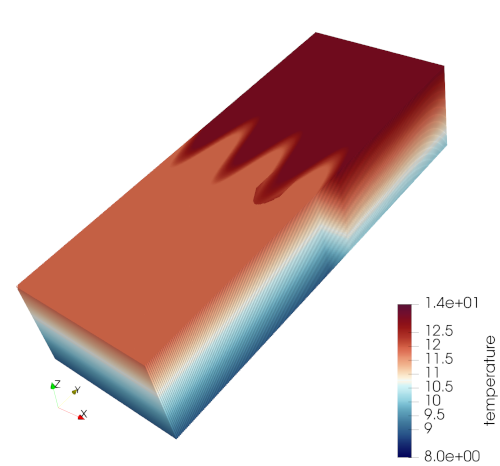baroclinic_channel
The ocean/baroclinic_channel test group implements variants of the
Baroclinic Eddies test case from
Ilicak et al. (2012).
The domain is zonally periodic with solid northern and southern boundaries. Salinity is constant throughout the domain (at 35 PSU). The initial temperature is cooler in the southern half of the domain than in the north, with a gradient between the two halves that is sinusoidally perturbed in the meridional direction. The surface temperature is also warmer than at depth.

Variants of the test case are available at 1-km, 4-km and 10-km horizontal resolution. By default, the 20 vertical layers each have 50-m uniform thickness.
The test group includes 5 test cases. All test cases have 2 steps,
initial_state, which defines the mesh and initial conditions for the model,
and forward (given another name in many test cases to distinguish multiple
forward runs), which performs time integration of the model.
config options
All 5 test cases share the same set of config options:
# Options related to the vertical grid
[vertical_grid]
# the type of vertical grid
grid_type = uniform
# Number of vertical levels
vert_levels = 20
# Depth of the bottom of the ocean
bottom_depth = 1000.0
# The type of vertical coordinate (e.g. z-level, z-star)
coord_type = z-star
# Whether to use "partial" or "full", or "None" to not alter the topography
partial_cell_type = None
# The minimum fraction of a layer for partial cells
min_pc_fraction = 0.1
# namelist options for baroclinic channel testcases
[baroclinic_channel]
# Logical flag that determines if locations of features are defined by distance
# or fractions. False means fractions.
use_distances = False
# Viscosity values to test for rpe test case
viscosities = 1, 5, 10, 20, 200
# Temperature of the surface in the northern half of the domain.
surface_temperature = 13.1
# Temperature of the bottom in the northern half of the domain.
bottom_temperature = 10.1
# Difference in the temperature field between the northern and southern halves
# of the domain.
temperature_difference = 1.2
# Fraction of domain in Y direction the temperature gradient should be linear
# over.
gradient_width_frac = 0.08
# Width of the temperature gradient around the center sin wave. Default value
# is relative to a 500km domain in Y.
gradient_width_dist = 40e3
# Salinity of the water in the entire domain.
salinity = 35.0
# Coriolis parameter for entire domain.
coriolis_parameter = -1.2e-4
All units are mks, with temperature in degrees Celsius and salinity in PSU.
default
ocean/baroclinic_channel/10km/default is the default version of the
baroclinic eddies test case for a short (15 min) test run and validation of
prognostic variables for regression testing. Currently, only 10-km horizontal
resolution is supported.
decomp_test
ocean/baroclinic_channel/10km/decomp_test runs a short (15 min) integration
of the model forward in time on 4 (4proc step) and then on 8 processors
(8proc step) to make sure the resulting prognostic variables are
bit-for-bit identical between the two runs. Currently, only 10-km horizontal
resolution is supported.
thread_test
ocean/baroclinic_channel/10km/thread_test runs a short (15 min) integration
of the model forward in time on 1 threads per processor (1thread step) and
then on 2 threads (2thread step) to make sure the resulting prognostic
variables are bit-for-bit identical between the two runs. Currently, only 10-km
horizontal resolution is supported.
restart_test
ocean/baroclinic_channel/10km/restart_test runs a short (10 min)
integration of the model forward in time (full_run step), saving a restart
file every 5 minutes. Then, a second run (restart_run step) is performed
from the restart file 5 minutes into the simulation and prognostic variables
are compared between the “full” and “restart” runs at minute 10 to make sure
they are bit-for-bit identical. Currently, only 10-km horizontal resolution is
supported.
rpe_test
ocean/baroclinic_channel/1km/rpe_test,
ocean/baroclinic_channel/4km/rpe_test, and
ocean/baroclinic_channel/10km/rpe_test perform longer (20 day) integration
of the model forward in time at 5 different values of the viscosity (with steps
named rpe_test_1_nu_1, rpe_test_2_nu_5, etc.) at any of the 3 supported
horizontal resolutions (1, 4 and 10 km). Results of these tests have been used
to show that MPAS-Ocean has lower spurious dissipation of reference potential
energy (RPE) than POP, MOM and MITgcm models
(Petersen et al. 2015).